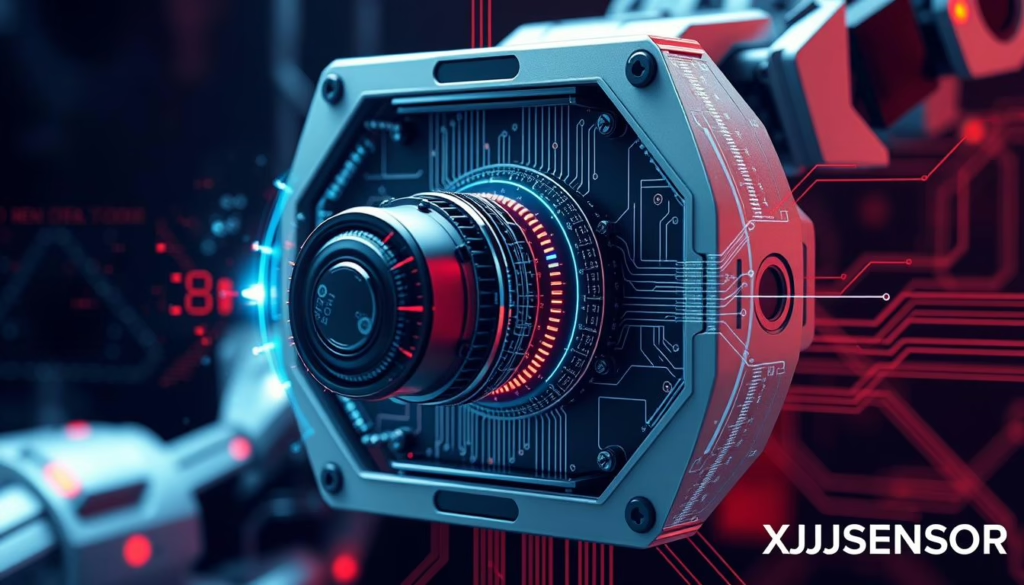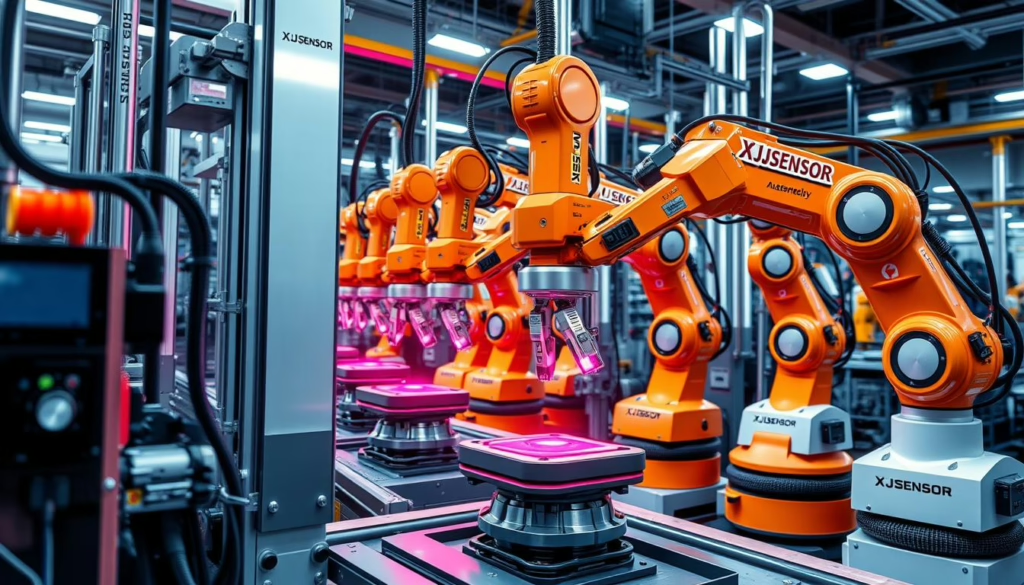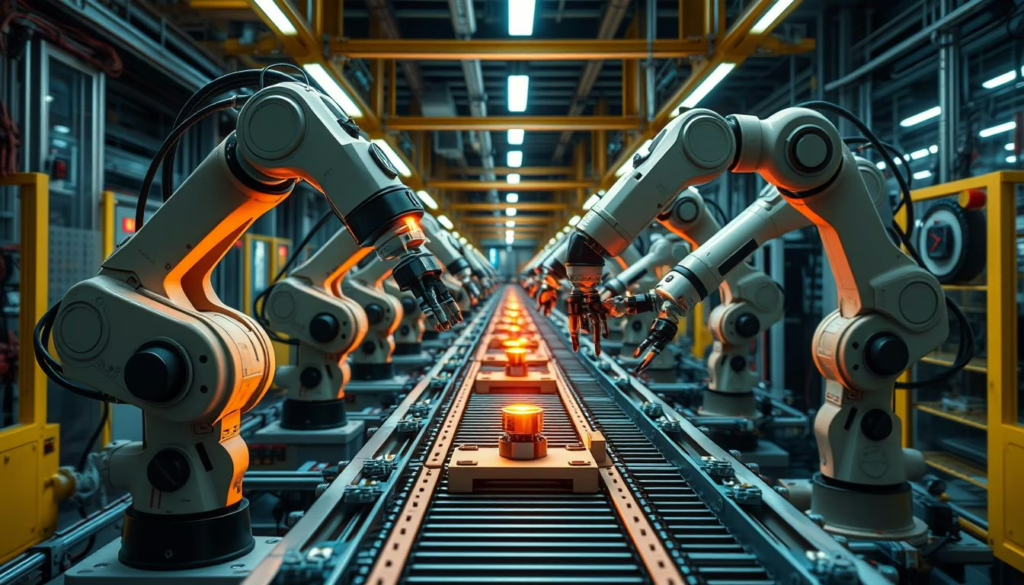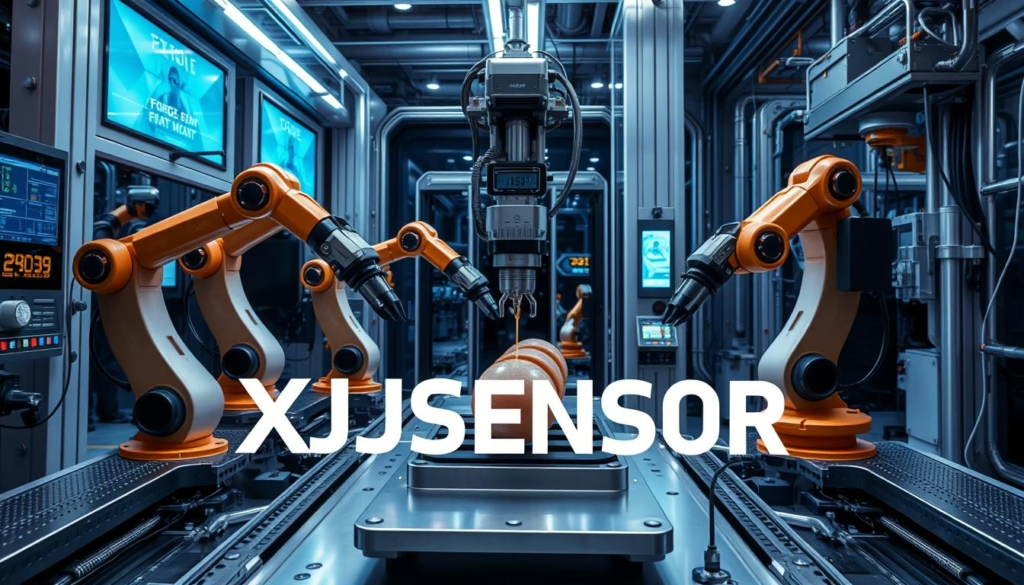In the world of force sensors in automated systems. They make automated systems much more accurate and efficient. Companies are getting ahead by using these sensors. XJCSENSOR is at the forefront, offering top-notch solutions. These enhancements improve how machines interact with their environment.
Key Takeaways
- Force sensors enhance the precision and efficiency of automated systems.
- Companies like XJCSENSOR are leading the way in force sensor technology.
- Force sensing in industrial automation is crucial for interacting seamlessly with the environment.
- Adopting force sensor integration solutions is a pivotal step towards advanced automation.
- Understanding the impact of force sensors can help companies stay competitive.
Introduction to Force Sensing Technology
Force sensing technology plays a critical role in modern automation. It turns mechanical force into measurable electrical signals. Force sensors, vital for various industrial uses, make this transformation possible. Understanding their function and evolution sheds light on their crucial role in technology today.
What are Force Sensors?
Force sensors are devices that respond to pressure, load, or tension. They change these forces into electrical signals that electronics can measure. These sensors are key for accurate force measurements in systems, essential for fields like robotics to medical devices.
History and Evolution of Force Sensing
The journey of force sensing technology began decades ago. It has shifted from simple mechanical tools to sophisticated electronic devices. Initially, force sensors were basic and manual. Yet, advances in technology have greatly increased their precision and reliability. Today’s force sensors use modern materials and designs, marking industry growth.
Types of Force Sensors
There are many force sensors, each serving different purposes. Here’s a glance at the most commonly used ones:
| Type of Force Sensor | Principle of Operation | Common Applications |
|---|---|---|
| Strain Gauge | Changes in electrical resistance due to deformation | Load cells, torque sensors |
| Piezoelectric | Electric charge generated by mechanical stress | Dynamic pressure measurement, accelerometers |
| Capacitive | Variation in capacitance with applied force | Touch sensors, force-sensitive resistors |
| Magnetic | Changes in magnetic field due to applied force | Magnetostrictive sensors, proximity sensors |
By utilizing these different force sensors, industries enhance performance and accuracy. This also improves force sensing technology integration in various applications.
Importance of Force Sensors in Automation
In automation, force sensors are key for top precision and efficiency. They measure forces on components, letting systems adjust instantly. This lets automation work better and more smoothly. Advanced force sensing tech helps producers increase precision in their systems.
Enhancing Precision and Efficiency
Force sensors boost precision and efficiency in automation. They monitor force on machinery and materials for high accuracy. Using sensors like those from XJCSENSOR minimizes errors and keeps machinery in check. This accuracy leads to better efficiency on production lines, cutting downtime and increasing output.
Role in Quality Control
Quality control matters a lot in making things, and force sensors are key here. They help ensure products meet tough quality standards. These sensors catch issues early, allowing for quick fixes. This way, the chance of making faulty goods drops, proving the value of force sensors. This leads to consistently good products, making customers happy and loyal.
Integration of Force Sensors in Automated Systems
Adding force sensors to automated systems needs careful planning. The aim is to make systems more efficient and accurate. This involves choosing the right force sensor solutions.
Key Considerations for Integration
When adding force sensors, several points need attention. Think about sensor type, the setting they’ll work in, their sensitivity, and what the system needs. Picking the right sensor makes things work better and last longer.
Compatibility with Existing Systems
It’s critical to check if new sensors fit with old equipment. Not all sensors will work with what you have, so you must closely look at how they connect. Sometimes, you’ll need special changes or tools to make everything work together. This lets old systems use new sensor tech well.
Integration Techniques and Strategies
Different ways can be used to add force sensors. It might mean updating what you have or doing a big upgrade. It’s important to find solutions that match what you need. Here, we compare various ways to integrate:
| Integration Technique | Advantages | Challenges | Applications |
|---|---|---|---|
| Retrofitting | Cost-effective, minimal downtime | Compatibility issues, limited by existing infrastructure | Older machinery, budget-constrained projects |
| System Overhaul | Optimal performance, future-proof | High cost, extended downtime | High-performance automation, new facility setups |
| Modular Integration | Flexible, scalable | Initial complexity, requires modular support | Modular production lines, configurable systems |
Automated Force Measurement Solutions
In today’s fast-paced industrial world, automated force measurement is key. It helps keep production quality high and efficiency up. By using these advanced solutions, businesses can get accurate readings. This leads to the best performance.
Real-Time Data Collection
Collecting data in real-time is crucial for automated force measurement systems. It lets industries watch their operations non-stop. This provides quick insights for fast, informed choices. Companies like XJCSENSOR are at the forefront of this, with their strong sensors. These sensors give accurate and quick data.
Accuracy and Reliability
Having precise and dependable solutions is vital. Today’s systems use top-notch sensors for unmatched accuracy. This reliability means our production stays consistent and top-quality, no matter what. Using automated force measurement technology keeps our quality control strict. It ensures our products remain excellent.
| Feature | Benefit |
|---|---|
| Automated Force Measurement | Ensures precise and consistent force readings |
| Real-Time Data Collection | Facilitates immediate decision-making with continuous monitoring |
| Accuracy | Maintains high production quality |
| Reliability | Guarantees consistent system performance |
Top Benefits of Force Sensors in Automation
Force sensing technology in automation brings many key benefits. It allows for precise and efficient automated processes. This leads to the production of high-quality products. High precision ensures consistency, minimizes defects, and keeps customers happy.
Also, force sensors help save money in automation. They detect small changes and problems, reducing waste and downtime. This optimizes the use of resources. The savings help keep prices competitive while maintaining quality.
Force sensing technology also improves safety in automated systems. It monitors and controls the force to prevent equipment from being overloaded. This reduces the risk of machinery failure and accidents. This safety is crucial in sectors like aerospace and medical manufacturing.
Another benefit of force sensors is they make production lines more adaptable. Systems with this technology can quickly adapt to changes in production needs. This flexibility is essential in today’s fast-moving industrial world.
In summary, adding force sensors to automated systems is a smart move. It not only improves product quality and safety but also helps save costs and makes production more adaptable. The adoption of this technology is key for businesses wanting to succeed in the competitive market today.
Force Sensor Applications in Robotics
Force sensors are changing how we work with robots. They let robots do fine and complex tasks better than ever. This progress is key for many areas and jobs.
Enhancing Robotic Capabilities
Force sensor applications in robotics help robots handle tasks needing careful attention and control. Precision assembly in manufacturing benefits greatly from this. Robots make sure parts fit right without damage. In healthcare, force sensors give surgical robots a way to feel their work. This makes delicate operations safer and more precise.
Examples of Robot Implementations
Force sensors make a big difference in robotics with many success stories. Here are some important ones:
- Manufacturing: Robots on assembly lines control grip strength perfectly with force sensors. This makes sure parts are placed correctly and safely.
- Healthcare: Force sensors give surgical robots feedback. Surgeons can sense through the robot, making precise cuts or stitches.
- Service Robots: Customer service robots also benefit. They handle fragile items carefully, preventing damage.
| Sector | Application | Benefit |
|---|---|---|
| Manufacturing | Precision assembly | Increased accuracy and reduced damage |
| Healthcare | Tactile feedback in surgery | Enhanced precision and safety |
| Service Robots | Handling fragile items | Improved user experience |
These examples show how force sensor applications in robotics transform various fields. They boost efficiency and accuracy everywhere. With advanced force sensing, robots are doing things we once only dreamed of.
Understanding Force Transducer Technology
Force transducer technology is key in force sensing in industrial automation. It changes force into an electrical signal. This allows for precise control and measurement in many industrial uses. The technology behind it is intriguing and worth looking into more.
These transducers work by sensing physical force and turning it into data. They use special materials for their sensitivity and strength. This makes the sensors both efficient and reliable.
The electronic systems inside the transducers are also vital. They take the signals from the sensors and turn them into digital data. This data is then used for making decisions in automation systems.
| Aspect | Description |
|---|---|
| Transduction Process | Conversion of physical force into electrical signal |
| Material Selection | Materials chosen for sensitivity and durability |
| Electronic Systems | Components that process and interpret signals |
| Industrial Applications | Automation, quality control, robotic systems |
Learning about force transducer tech helps us understand its role in force sensing in industrial automation. It’s key for creating custom solutions for industrial needs.
Challenges in Force Sensor Integration
Integrating force sensors into automated systems comes with challenges. It’s key to understand these to succeed and get precise results.
Technical Challenges
One big hurdle is environmental interference. Changes in temperature and humidity can mess with sensor accuracy. Also, there may be compatibility issues with current systems. These can make it hard to integrate everything smoothly.
Another issue is understanding the data sensors give us. They produce lots of data that must be processed correctly. Without good data management tools, it’s easy to get lost in the information.
Solution-Based Approaches
To solve these issues, there are several steps we can take. Using advanced calibration can lessen environmental problems. This way, sensors work well in different settings. Introducing specialized software helps fit new sensors into existing setups easily.
Getting help from experienced providers like XJCSENSOR is also smart. They know how to offer custom solutions for varying needs. This makes integrating force sensors much easier.
A smart plan that looks at technical pitfalls and uses smart fixes is key for successful sensor integration.
Here’s a table showing usual challenges and how to fix them:
| Challenges | Solutions |
|---|---|
| Environmental Interference | Advanced Calibration Techniques |
| Compatibility Issues | Specialized Software Integration |
| Complex Data Interpretation | Consulting with Experts |
Optimizing Force Sensing in Industrial Automation
To make force sensing better in automation, we need a bespoke approach. This approach must suit the needs of different industries. Businesses like aerospace, automotive, and packaging need special solutions for better efficiency and precision.
Custom Solutions for Specific Industries
We create custom solutions for specific industries to improve force sensing. Sectors such as aerospace, automotive, and packaging have their own needs. Our bespoke methods tackle these unique challenges and make operations smoother. This leads to higher productivity.
Case Studies of Successful Implementations
Looking at real-world examples shows force sensing’s benefits. In the automotive industry, a case study revealed major performance boosts and less downtime. This was achieved by using custom solutions designed for specific industries.
Another example from the aerospace sector showed better manufacturing accuracy. This increase in precision led to more profits. These cases show how customized force sensing solutions can greatly improve efficiency and effectiveness.
Future Trends in Force Sensor Technology
Force sensor technology is always moving forward. Looking ahead, we see trends that will really change how force sensing works.
Innovations Driving the Future
Miniaturization is a big trend. Smaller sensors will be used in wearables and small machines. There’s also a push for better sensitivity. This will allow for finer measurements and catching small force changes.
Software is also getting better. Now, sensors can analyze data in real time. They measure force and even foresee problems. This brings a big boost in how well things run.
The Role of AI in Force Sensing
The use of AI in force sensing is a game changer. AI makes sensors smarter and self-learning. They adapt and get better as they work. This is key for solutions that work on their own, handling intricate jobs with little help from humans.
AI also enables exciting uses. Think about robotic surgery or smart homes. With AI, sensors give updates quickly, helping make fast, right choices. The future of force sensors counts on AI to lead these improvements.
Conclusion
Adding force sensors to automated systems is a big step forward in industrial automation. This new technology brings unmatched accuracy. It improves the quality of automated tasks hugely. In our complex industrial world, force sensors do more than just measure. They are key to connecting and syncing different platforms perfectly.
Force sensors offer many benefits. They give us real-time data, are accurate, and reliable. These qualities are vital for better automation. Companies like XJCSENSOR are at the forefront, offering innovative solutions. With these advancements, industries can make their operations smoother and boost productivity.
The future of industrial automation looks bright. With ongoing improvements and the arrival of new trends, it’s an exciting time. Technologies like artificial intelligence will push the use of force sensors even further. As we keep up with these changes, smarter, more efficient automation is becoming a reality. This means our industries will be better prepared for future challenges and opportunities.






